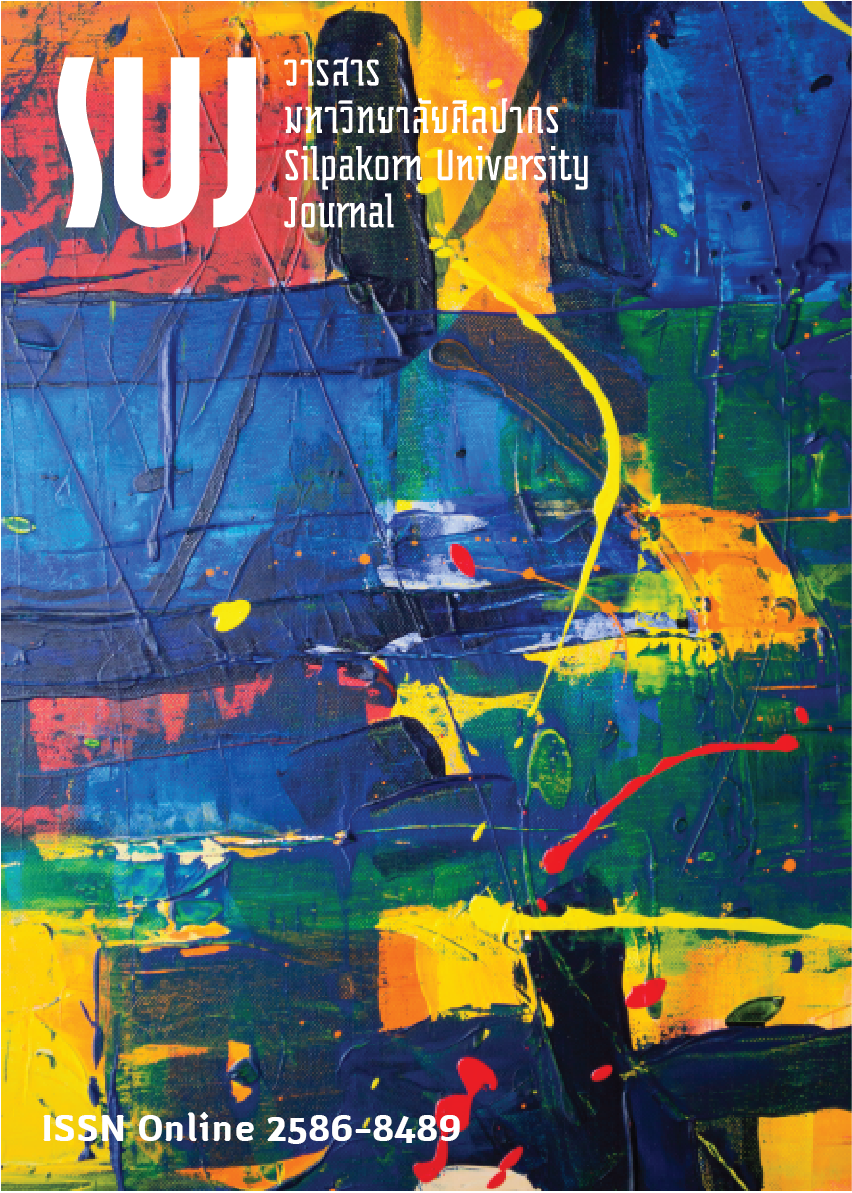ปัจจัยที่มีอิทธิพลต่อความตั้งใจชำระเงินผ่านธนาคารทางโทรศัพท์มือถือของนักศึกษามหาวิทยาลัยสงขลานครินทร์ วิทยาเขตตรัง (Factors influencing mobile banking adoption intention of students in Prince of Songkla University, Trang Campus)
Main Article Content
Abstract
จากอัตราการเติบโตของการทำธุรกรรมผ่านธนาคารทางโทรศัพท์มือถืออย่างต่อเนื่อง ผู้บริโภคนิยมใช้เพื่อการโอนเงินและซื้อสินค้าหรือบริการออนไลน์ ทั้งนี้วัยนักศึกษาถือเป็นประชากรที่มีการเปิดรับและบริโภคเทคโนโลยีมากที่สุดกลุ่มหนึ่ง งานวิจัยนี้เป็นการวิจัยแบบผสมผสานวิธีเพื่อศึกษาพฤติกรรมการชำระเงินผ่านธนาคารทางโทรศัพท์มือถือ รวมทั้งศึกษาปัจจัยที่มีอิทธิพลต่อความตั้งใจชำระเงินผ่านธนาคารทางโทรศัพท์มือถือของนักศึกษามหาวิทยาลัยสงขลานครินทร์ วิทยาเขตตรัง โดยใช้ส่วนขยายทฤษฎีรวมการยอมรับการใช้เทคโนโลยี (UTAUT2) ร่วมกับความเชื่อมั่นและการรับรู้ความปลอดภัย กลุ่มตัวอย่างเป็นนักศึกษาระดับปริญญาตรี มหาวิทยาลัยสงขลานครินทร์ วิทยาเขตตรัง จำนวน 508 คน ซึ่งได้จากการสุ่มตัวอย่างแบบเจาะจง เครื่องมือที่ใช้ในการวิจัย คือ แบบสอบถามและการสนทนากลุ่ม สถิติที่ใช้ในการวิเคราะห์ข้อมูล ได้แก่ ความถี่ ร้อยละ ค่าสัมประสิทธิ์ภายนอก ค่าสัมประสิทธิ์แอลฟาของครอนบัค ความแปรปรวนร่วม และความเชื่อมั่นรวมของตัวแปรแฝง ค่าความเที่ยงตรงรายตัวแปรตามวิธี Fornell-Larcker และค่าความเที่ยงตรงรายข้อถาม ค่าสัมประสิทธิ์การกำหนด และแบบจำลองสมการโครงสร้างกำลังสองน้อยที่สุดเชิงส่วน ผลการวิจัยพบว่า ผู้ตอบแบบสอบถามส่วนใหญ่มีประสบการณ์ชำระเงินผ่านธนาคารทางโทรศัพท์มือถือ 1 - 2 ปี และความถี่ ในการใช้ 1 - 3 ครั้งต่อเดือน โดยใช้เพื่อโอนเงินไปยังบัญชีอื่นหรือซื้อสินค้าหรือบริการออนไลน์ในเว็บไซต์ ปัจจัยที่มีอิทธิพลต่อความตั้งใจชำระเงินผ่านธนาคารทางโทรศัพท์มือถือ ได้แก่ ความเชื่อมั่นการรับรู้ความปลอดภัยและความเคยชิน นอกจากนี้การรับรู้ความปลอดภัยยังมีอิทธิพลต่อความเชื่อมั่น ในขณะที่ปัจจัยอื่น ๆ ไม่มีอิทธิพลต่อการใช้งานการชำระเงินผ่านธนาคารทางโทรศัพท์มือถือ เนื่องจากร้านค้าและบุคคลแวดล้อมไม่มีการใช้งานนักศึกษาไม่มีความชำนาญและไม่สามารถขอคำแนะนำเมื่อเกิดปัญหาการใช้งาน สัญญาณโทรศัพท์ไม่ครอบคลุมในบางพื้นที่ และบางแพ็กเกจโทรศัพท์ไม่สนับสนุนการเชื่อมต่ออินเทอร์เน็ตแบบตลอดเวลา เป็นต้น นอกจากนี้ นักศึกษาที่มีเพศแตกต่างกัน มีความคิดเห็นต่อปัจจัยความตั้งใจชำระเงินผ่านโทรศัพท์มือถือไม่แตกต่างกัน
Presently, mobile banking transaction rapidly grows, especially for money transferring and online shopping. It can be claimed that the appearance of mobile banking is from the use of the new generation. Students are considered one of the technology-consuming population groups. Consequently, this research applied the mixed method research and aimed to investigate the behavior and factors influencing mobile-banking adoption intention of students in Prince of Songkla University, Trang Campus. By using the extended unified theory of acceptance and use of technology (UTAUT2) with trust and security perceptions, 508 samples were purposefully selected for investigation. The research tools included a questionnaire and a focus group survey. The statistics used for data analysis are frequency, percentage, outer loading, Cronbach’s alpha coefficient, composite reliability (CR), average variance extracted (AVE), discriminant validity by Fornell-Larcker criterion, cross loading, coefficient of determination (R2), and partial least squares structural equation modeling (PLS-SEM). The results reveal that most of users are female; the mobile-banking adoption period varies from one to two years; the main purpose of mobile-banking is for money transferring and online shopping, with the frequency of one to three times per month. Contributing factors for mobile-banking adoption intention are trust, habit, and perceived security, where perceived security has an influence on trust. The causes of rejection of mobile-banking adoption intention are merchants and people around, and no experience and no advice for troubleshooting. Moreover, the stability of the mobile phone signal is a factor, as well as a lack of mobile Internet packages. In addition, students with different genders have no different opinions on mobile-banking adoption intention.
Downloads
Article Details

This work is licensed under a Creative Commons Attribution-NonCommercial-NoDerivatives 4.0 International License.
References
Alalwan, A. A., Dwivedi, Y. K., & Rana, N. P. (2017). Factors Influencing Adoption of Mobile Banking by Jordanian Bank Customers: Extending UTAUT2 with Trust. International Journal of Information Management, 37(3): 99-110.
Bank of Thailand. (2017). Payment System Report 2017. [Online]. Retrieved January 29, 2019 from https://bit.ly/2SFCUQf
Bank of Thailand. (2019). Payment Transactions. [Online]. Retrieved March 12, 2019 from https://bit.ly/2HDC6rr
Boonsiritomachai, Waranpong, & Pitchayadejanant, Krittipat. (2017). Determinants Affecting Mobile Banking Adoption by Generation Y based on the Unified Theory of Acceptance and Use of Technology Model Modified by the Technology Acceptance Model concept. Kasetsart Journal of Social Sciences, 40(2): 349-358.
Chaiyasoonthorn, Wornchanok. (2015). The Adoption of Electronic Payment in Thailand. Bangkok: King Mongkut’s Institute of Technology Ladkrabang.
Chandra, S., Srivastava, S. C., & Teng, Y. (2010). Evaluating the Role of Trust in Consumer Adoption of Mobile Payment Systems: An Empirical Analysis. Communications of the Association for Information Systems, 27(29): 561-588.
Chaweesuk, Singha, & Vongjaturapat, Sununthar. (2012). Unified Theory of Acceptance and Use of Technology (ทฤษฎีการยอมรับการใช้เทคโนโลยีสารสนเทศ). KMITL Journal of Information Technology, 1(1): 1-21.
Johnson, V. L., Kiser, A., Washington, R., & Torres, R. (2018). Limitations to the Rapid Adoption of M-Payment Services: Understanding the Impact of Privacy Risk on M-Payment Services. Computers in Human Behavior, 79: 111-122.
Kassim, N. Md. (2017). Effect of Perceived Security and Perceived Privacy towards Trust and the Influence on Internet Banking Usage among Malaysians. International Academic Journal of Social Sciences, 4(2): 26-36.
Kim, D. J., Ferrin, D. L., & Rao, H. R. (2008). A Trust Based Consumer Decision Making Model in & Electronic Commerce: The Role of Trust, Perceived Risk and Their Antecedents. Decision Support Systems, 44(2): 544-564.
Kim, G., Shin, B., & Lee, G. H. (2009). Understanding Dynamics Between Initial Trust and Usage Intentions of Mobile Banking. Information Systems Journal, 19(3): 283-311.
Magsamen-Conrad, K., Upadhyaya, S., Joa, C., & Dowda, J. (2015). Bridging The Divide: Using UTAUT to Predict Multigenerational Tablet Adoption Practices. Computers in Human Behavior, 50: 186-196.
Mardjo, A. (2018). Exploring Facebook Users’ Willingness to Accept F-Commerce Using The Integrated Unified Theory of Acceptance and Use of Technology 2 (UTAUT2), Trust and Risk Under The Moderating Role of Age and Gender. UTCC International Journal of Business and Economics, 10(2): 139-165.
Office of the Prime Minister. (2016). The Twelve National Economic and Social Development Plan (แผนพัฒนาเศรษฐกิจและสังคมแห่งชาติ ฉบับที่สิบสอง พ.ศ.2560-2564). [Online]. Retrieved January 12, 2019 from https://bit.ly/2TvpMMH
Oliveira, T., Thomas, M., Baptista, G., & Campos, F. (2016). Mobile Payment: Understanding the Determinants of Customer Adoption and Intention to Recommend the Technology. Computers in Human Behavior, 61: 404-414.
Phonthanukitithaworn, Chanchai, & Sellitto, C. (2016). An Investigation of Mobile Payment (M-Payment) Services in Thailand. Asia-Pacific Journal of Business Administration, 8(1): 37-54.
Piriyakul, Montree. (2010). Partial Least Square Path Modeling (PLS Path Modeling) (ตัวแปรแบบเส้นทางกำลังสองน้อยที่สุดบางส่วน). In The 11th Statistics and Applied Statistics Conference, (pp. C1-C22). Retrieved August 12, 2019 from http://www.research.ru.ac.th/images/ArticleMr/1501822585_Article.pdf
Saetim, Siripan. (2018). Finance and Electronic Payment Systems (1st ed.). Trang: Prince of Songkla University, Trang Campus.
Venkatesh, V., Thong, J. Y. L., & Xu, X. (2012). Consumer Acceptance and Use of Information Technology: Extending the Unified Theory of Acceptance and Use of Technology. MIS Quarterly, 36(1): 157-178.
Zhou, T. (2011). The Effect of Initial Trust on User Adoption of Mobile Payment. Information Development, 27(4): 290-300.
Zhou, T. (2013). An Empirical Examination of Continuance Intention of Mobile Payment Services. Decision Support Systems, 54(2): 1085-1091.


